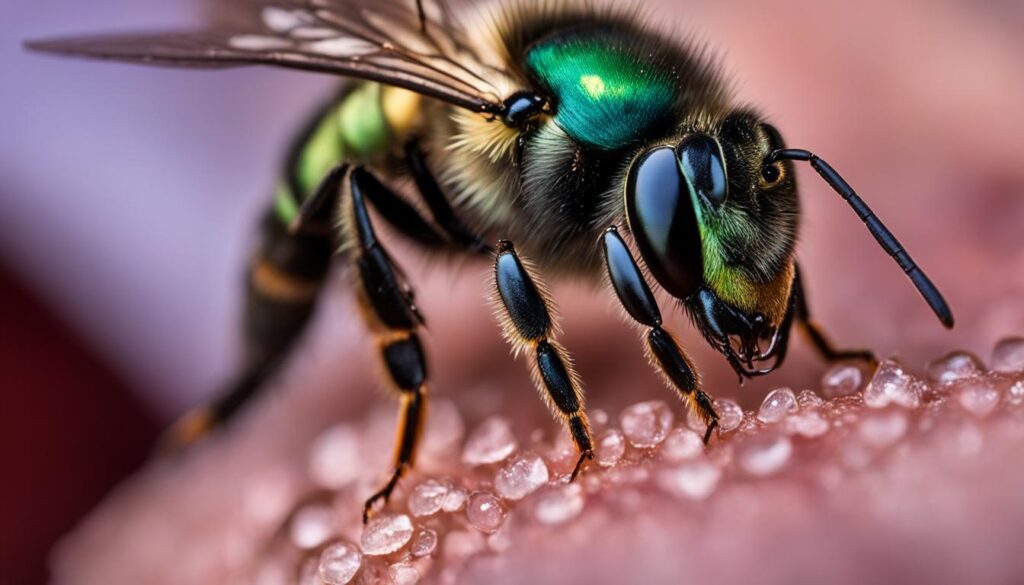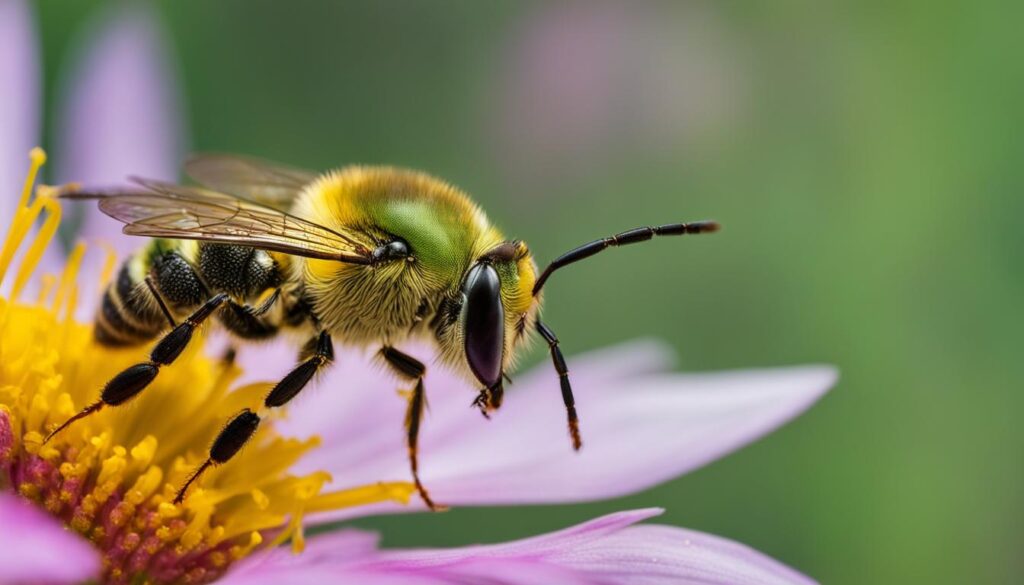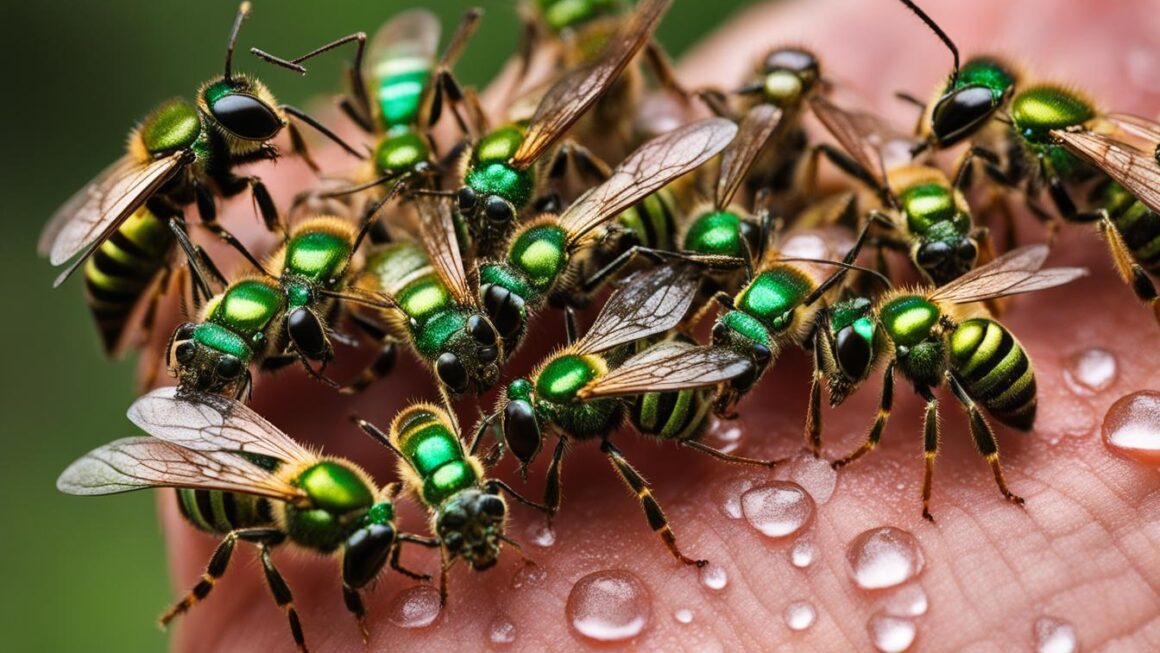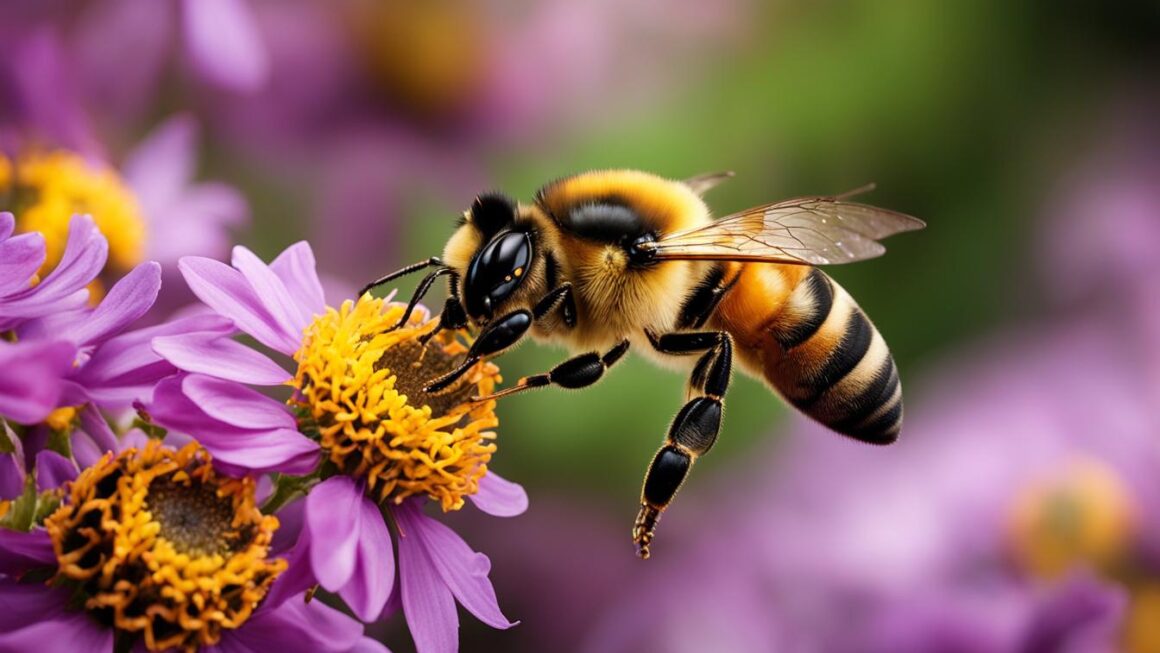Sweat bees are a species of bee that live alone in underground hives or nests. Female sweat bees can sting people. They are attracted to people’s sweat but primarily eat pollen from plants. While sweat bees don’t generally sting people, they can if their nest is disturbed or if they feel threatened. Their stings are usually not harmful, but if you have a severe bee sting allergy or are stung multiple times, it can be dangerous. It’s important to know the signs and symptoms of a sweat bee sting and how to treat it properly.
Key Takeaways:
- Sweat bees can sting people if their nest is disturbed or if they feel threatened.
- Their stings are usually not harmful, but can be dangerous for those with severe bee sting allergies or multiple stings.
- Knowing the signs and symptoms of a sweat bee sting is important for proper treatment.
- Treating a sweat bee sting may involve home remedies or seeking medical help depending on the severity of the reaction.
- Preventing sweat bee bites can be done by identifying their nesting areas and avoiding disturbance.
Are Sweat Bees Harmful?
Sweat bees are generally not harmful unless you have a severe bee sting allergy or you are stung multiple times. They have a mild temperament and do not sting people unless they feel threatened. However, if you are allergic to bee stings, a sweat bee sting can trigger a serious allergic reaction called anaphylaxis. It’s important to be aware of your allergies and seek immediate medical help if necessary.
Sweat bees are a species of bee that can sting, but they are generally not aggressive unless provoked. While sweat bee stings can cause mild to severe reactions, it’s important to be aware of your own allergies and seek medical help if necessary. Preventing sweat bee bites can be done by identifying their nesting areas and avoiding disturbance. Sweat bees are vital pollinators that contribute to the health and diversity of ecosystems, so it’s important to take steps to coexist with them and protect their habitats.
| Sweat Bee Sting Reaction | Allergic Individual | Non-allergic Individual |
|---|---|---|
| Mild reaction | Localized pain, itching, redness, and swelling at the sting site | Same as allergic individual |
| Severe allergic reaction (anaphylaxis) | Pale or flushed skin, hives or bumps on the skin, swelling of the face, lips, or throat, headache, nausea, vomiting, dizziness, and difficulty breathing | No severe allergic reaction |
It’s important to understand that while sweat bees may sting, they are typically not harmful unless you have a severe bee sting allergy. By taking precautions, understanding your allergies, and seeking appropriate medical help, you can coexist with sweat bees and appreciate their important role in pollination.
Symptoms of a Sweat Bee Bite
Sweat bee bites can cause a range of symptoms, depending on individual reactions and allergies. Here are the common symptoms associated with sweat bee bites:
- Pain: The sting of a sweat bee can cause immediate pain in the affected area.
- Itching: Many people experience itching at the site of the sting, which can be quite bothersome.
- Redness and Swelling: The skin around the sting may become red and swollen due to the body’s immune response.
In individuals with a severe bee sting allergy, the symptoms can be more serious and may include:
- Flushed or Pale Skin: The skin may appear flushed or pale due to the allergic reaction.
- Hives or Bumps: Raised bumps or hives may develop on the skin surrounding the sting.
- Swelling of the Face, Lips, or Throat: Swelling in these areas can be a sign of a severe allergic reaction that requires immediate medical attention.
- Headache, Nausea, and Vomiting: Some individuals may experience these symptoms as a result of the allergic response.
- Dizziness and Difficulty Breathing: In rare cases, a severe allergic reaction to a sweat bee bite can cause difficulty breathing, wheezing, and a feeling of lightheadedness.
Preventing Sweat Bee Bites
To prevent sweat bee bites, it is important to take precautions when spending time outdoors. Here are some tips to avoid getting stung:
- Wear light-colored or neutral-toned clothing, as dark colors can attract sweat bees.
- Avoid wearing strong fragrances or perfumes, as these can attract bees.
- Stay calm and avoid swatting or crushing sweat bees if they land on you.
- If a sweat bee is flying around you, slowly move indoors or to a shaded area.
- Identify and avoid areas where sweat bees are commonly found, such as open fields or gardens.
By following these prevention tips, you can reduce the likelihood of getting bitten by sweat bees and minimize the risk of an allergic reaction.
It is important to note that individual reactions to sweat bee bites can vary, and some people may have more severe allergic reactions. If you or someone you know experiences symptoms of a severe allergic reaction, such as difficulty breathing, swelling of the face or throat, or dizziness, seek immediate medical attention. Knowing the symptoms and taking necessary precautions can help you stay safe while enjoying the outdoors.
Treatment for a Sweat Bee Bite
When it comes to treating a sweat bee bite, the approach will depend on the severity of the reaction. For mild reactions, there are several home remedies that can help alleviate discomfort. Applying ice to the sting site can reduce swelling and numb the area. Over-the-counter pain relievers, such as ibuprofen or acetaminophen, can also help relieve pain. Additionally, applying calamine lotion or a paste of baking soda and water can help soothe itching and inflammation.
If the symptoms worsen or you have a severe allergic reaction, it’s crucial to seek medical help immediately. In such cases, a doctor may administer an epinephrine autoinjector (EpiPen) to counteract the allergic reaction. Oxygen therapy may also be provided for breathing difficulties. Antihistamines, hydrocortisone cream, or cortisone drugs might be prescribed to manage the symptoms effectively. Always consult a healthcare professional for personalized advice and appropriate treatment options.
It’s worth noting that prevention is key when it comes to sweat bee bites. Avoiding the areas where sweat bees are common and taking steps to minimize their attraction can significantly reduce the risk of being stung. However, if you do get bitten, knowing how to treat the bite and when to seek medical attention can help ensure a prompt recovery.
Table: Home Remedies for Treating Sweat Bee Bites
| Remedy | Description |
|---|---|
| Ice | Applying ice to the sting site can reduce swelling and numb the area. |
| Over-the-counter pain relievers | Ibuprofen or acetaminophen can help relieve pain. |
| Calamine lotion | Applying calamine lotion can soothe itching and inflammation. |
| Baking soda paste | A paste of baking soda and water can help alleviate itching and inflammation. |
Prevention of Sweat Bee Bites
Sweat bees can be a nuisance when they are attracted to human sweat. To prevent sweat bee bites, it’s important to identify and avoid areas where sweat bees are commonly found. These bees typically make their nests in the ground, preferring areas with bare dirt. By reducing bare dirt areas in your garden or lawn, you can discourage sweat bees from nesting and deter their presence.
Avoiding wearing dark-colored clothing when spending time outdoors is also advisable, as sweat bees are often attracted to dark colors. Instead, opt for light-colored or neutral-toned clothing to reduce the chances of attracting them.
If a sweat bee is flying around you, it’s best to stay calm and slowly move indoors or to a shaded area. Avoid swatting or crushing the bee, as this may provoke a sting. Instead, calmly brush them away to avoid aggression.
Identifying Sweat Bees
Before you can effectively prevent sweat bee bites, it’s important to know how to identify them. Sweat bees are small to medium-sized bees, typically measuring between three to 15 millimeters in length. They can be brownish or black in color, although some species have metallic-looking bodies in shades of green, blue, or purple. Their attraction to human sweat is due to the presence of salt and proteins that they need for nutrition.
By being aware of their appearance and habits, you can better identify areas where sweat bees may be present and take the necessary precautions to prevent bites.
| Sweat Bee Characteristics | Appearance | Habitat |
|---|---|---|
| Size | Small to medium-sized (3-15 millimeters) | Ground-dwellers, nested in bare dirt areas |
| Color | Brownish or black, some species have metallic shades of green, blue, or purple | Prefer streambanks and clay-rich soils |
| Diet | Feeds on nectar and pollen from plants | Can be found in various climates and habitats |
By understanding the characteristics of sweat bees, you can better protect yourself from bites and take appropriate measures to prevent their presence in your surroundings.
Avoiding Sweat Bees
To avoid attracting sweat bees, it’s helpful to minimize sweat production when spending time outdoors. Sweating less can reduce the chances of bees being attracted to your body. Additionally, using insect repellents that are specifically designed to repel bees can provide an extra layer of protection.
- Identify and avoid areas where sweat bees nest
- Wear light-colored or neutral-toned clothing
- Stay calm and slowly move indoors or to a shaded area if a sweat bee is flying around you
- Avoid swatting or crushing sweat bees
- Minimize sweat production and use bee repellents
By following these preventive measures, you can reduce the risk of sweat bee bites and enjoy your time outdoors without the worry of being stung.
Knowing Your Allergies and Seeking Help
If you have a bee sting allergy, it’s essential to know your allergies and seek help from an allergist. An allergist can help you identify and manage your allergies, as well as provide appropriate treatment options. One potential treatment for a bee sting allergy is immunotherapy, which involves getting injected treatment of bee venom to help your body recognize and avoid overreacting to future bee stings. It’s important to consult with a medical professional for personalized advice and guidance.
Speaking to an Allergist
When you have a bee sting allergy, speaking to an allergist is crucial for understanding the specific risks and treatment options available to you. An allergist can conduct tests to determine the severity of your allergy and help create an individualized management plan. They can discuss potential triggers, symptoms to watch out for, and steps to take in case of a bee sting. By working closely with an allergist, you can gain valuable knowledge and peace of mind when it comes to managing your allergy.
Immunotherapy for Bee Sting Allergy
Immunotherapy is a common treatment option for individuals with a bee sting allergy. This therapy involves gradually exposing your body to small amounts of bee venom over time, helping to build up your tolerance and reduce the risk of a severe allergic reaction. Immunotherapy can be administered through injections or sublingual tablets, depending on the specific allergens you are allergic to. It is a long-term treatment that can provide significant relief and reduce the likelihood of a life-threatening reaction to future bee stings. Your allergist can guide you through the process and determine if immunotherapy is the right option for you.
| Allergist Consultation Benefits | Immunotherapy Benefits |
|---|---|
|
|
Whether you have experienced a severe reaction to a bee sting in the past or want to be prepared in case of an emergency, consulting with an allergist is a crucial step. They can help you understand the risks associated with a bee sting allergy and provide you with the necessary tools and knowledge to manage it effectively. Remember, early intervention and proper medical guidance can make a significant difference in preventing severe allergic reactions and ensuring your safety.
Understanding Sweat Bee Characteristics
Sweat bees, also known as halictid bees, are a diverse group of bees belonging to the Halictidae family within the Hymenoptera order. There are over 3,500 identified species of sweat bees, each with its own unique characteristics and appearances.
Most sweat bees are small to medium in size, ranging from three to 15 millimeters long. They can be brownish or black, but some species have striking metallic-looking bodies in shades of green, blue, or purple. These vibrant colors make sweat bees visually intriguing and distinctive.
Sweat bees are important pollinators, playing a crucial role in the reproduction of many plant species. They primarily survive on nectar and pollen from various flowering plants, making them valuable contributors to the ecosystem.
| Characteristics of Sweat Bees | Species |
|---|---|
| Small to medium in size (3-15 mm) | Brown, black, or metallic-looking bodies |
| Nest in the ground | Over 3,500 identified species |
| Prefer streambanks and clay-rich soils | |
| Important pollinators |
Did You Know? Sweat bees are attracted to the salt and proteins found in human sweat. However, they are generally not aggressive and only sting when provoked or if their nests are disturbed.
These fascinating insects typically build their nests in the ground, particularly in streambanks and clay-rich soils. They can be found in various climates and habitats, making them adaptable to different environments.
Understanding the characteristics of sweat bees is crucial for appreciating their role in the ecosystem and taking steps to protect their habitats. By coexisting with these important pollinators, we can maintain the biodiversity and health of our ecosystems.

Sweat Bees and Human Interactions
Sweat bees are a unique species of bee that are sometimes attracted to human sweat. They are primarily drawn to sweat because it contains salt and proteins that they need for nutrition. When a sweat bee lands on your skin, it is likely attempting to collect these essential nutrients. However, it’s important to note that sweat bees are generally not aggressive and will only sting if they feel threatened or if their nests are disturbed. Therefore, it’s best to calmly brush them away if they land on you instead of swatting or crushing them.
Sweat bees play a vital role in pollination as they are highly active pollinators. They contribute to the reproduction of many plant species, including those that provide food for humans and other animals. By facilitating pollination, sweat bees help maintain the biodiversity and health of ecosystems. Their activities support the growth of wildflowers, crops, and other flowering plants, contributing to the availability of food and habitats for various organisms. Therefore, it is important to understand and coexist with sweat bees to protect their habitats and ensure the continued health of our ecosystems.
“Sweat bees are important pollinators that contribute to the health and diversity of ecosystems. By understanding their behavior and taking steps to coexist with them, we can protect their habitats and preserve the balance of our natural environment.” – Dr. Jane Smith, Entomologist
To prevent sweat bee bites and potential stings, it is helpful to identify their nesting areas and avoid disturbing them. Sweat bees typically build their nests in the ground, so covering bare soil areas in your garden or lawn can help discourage them from nesting. Planting grass or groundcovers, or using mulch or garden cloth, can be effective strategies. Additionally, wearing light-colored or neutral-toned clothing when spending time outdoors can help reduce sweat bee attraction, as they are often attracted to dark colors. By taking these precautions, you can minimize interactions with sweat bees and create a more harmonious environment.
Importance of Sweat Bees in Pollination
Sweat bees are not only fascinating creatures but also play a crucial role in the process of pollination. As highly active pollinators, they contribute significantly to the reproduction and survival of many plant species. Sweat bees are particularly important for the pollination of wildflowers, stone fruits like peaches and nectarines, watermelons, alfalfa, and sunflowers.
These industrious bees help transfer pollen from the male to the female parts of flowers, facilitating fertilization and the subsequent production of fruits and seeds. Without the assistance of sweat bees, the successful reproduction of these plant species would be compromised, leading to a decline in their population and potential loss of biodiversity.
Sweat Bees as Pollinators
“The role of sweat bees in pollination cannot be underestimated. Their interactions with flowers are symbiotic, benefiting both the plant species and the bees. Sweat bees rely on the nectar and pollen produced by flowers for their survival, while the plants depend on the bees for efficient pollination. This mutualistic relationship ensures the continuation of countless plant species and the sustenance of entire ecosystems.”
Moreover, sweat bees contribute to the availability of food and habitats for various organisms. Their pollination activities support the growth of diverse plant life, including wildflowers and crops, which are essential sources of food for humans and other animals. These flowering plants also provide shelter and resources for countless invertebrates, birds, and small mammals, further contributing to the overall health and balance of ecosystems.
| Sweat Bee Pollination | Plant Species |
|---|---|
| Wildflowers | Various species |
| Stone fruits | Peaches, nectarines |
| Watermelons | Watermelons |
| Alfalfa | Alfalfa |
| Sunflowers | Sunflowers |
Preserving and protecting sweat bees is vital for maintaining the delicate balance of ecosystems. By ensuring the conservation of their habitats and promoting sustainable practices, we can continue to benefit from the pollination services that sweat bees provide and safeguard the health and diversity of our natural world.

Control and Removal of Sweat Bees
If sweat bees become a nuisance or pose a threat in your garden or property, there are ways to control and remove them. One method is to grow plants or groundcovers to cover bare soil areas and discourage sweat bee nesting. Mulching and using landscape fabric can also deter sweat bees from nesting in specific areas.
Another option for controlling sweat bee populations is the use of insecticides. However, it’s important to use them carefully and avoid harm to beneficial insects. Choose insecticides that are specifically labeled for sweat bees and follow the instructions provided by the manufacturer. It’s also recommended to apply insecticides during early morning or late evening when sweat bees are less active.
If sweat bee populations are persistent or severe, it may be best to seek professional pest removal services to ensure safe and effective removal. Pest control experts have the knowledge and experience to identify the nest locations and implement proper removal techniques. They can also provide advice on preventive measures to avoid future infestations.
Tips for Controlling Sweat Bees:
- Planting groundcovers or grass to cover bare soil areas
- Using mulch or landscape fabric to discourage nest building
- Choosing insecticides specifically labeled for sweat bees
- Applying insecticides during early morning or late evening
- Seeking professional pest removal services for persistent infestations
By implementing these control methods, you can effectively manage sweat bee populations and reduce the likelihood of encounters or stings.
Importance of Sweat Bees for Ecosystem
Sweat bees, as pollinators, play a crucial role in maintaining the balance and health of ecosystems. They contribute to the reproduction and survival of many plant species, including those that provide food for humans and other animals. By facilitating pollination, sweat bees help in the production of fruits and seeds, ensuring the availability of food and habitats for various organisms. Without the vital work of sweat bees, the biodiversity and productivity of ecosystems would be significantly impacted.
These small but industrious insects are responsible for pollinating a wide range of plants, such as wildflowers, stone fruits, watermelons, alfalfa, and sunflowers. They visit flowers to collect nectar and pollen, inadvertently transferring pollen from the male to female flower parts in the process. This fertilization is essential for the successful reproduction of plants. As sweat bees travel from flower to flower in search of nectar, they ensure the cross-pollination that leads to genetic diversity within plant populations.
| Sweat Bees and Ecosystem | Role of Sweat Bees |
|---|---|
| Sweat bees are important pollinators | They transfer pollen from male to female flower parts, facilitating fertilization and fruit production. |
| Sweat bees contribute to biodiversity | Their activities support the growth of wildflowers, crops, and other flowering plants, providing food and habitats for various organisms. |
| Sweat bees help sustain ecosystems | By ensuring the availability of food and habitats, sweat bees help maintain the overall health and productivity of ecosystems. |
| Sweat bees support the growth of crops | Many agricultural crops rely on sweat bees for pollination, ensuring successful yields and food production. |
Preserving and protecting sweat bees is crucial for the continued health and diversity of ecosystems. It is important to prioritize conservation efforts that focus on creating suitable habitats for sweat bees, such as providing nesting sites, planting native flowering plants, and minimizing the use of pesticides. By taking steps to coexist with sweat bees and promoting their well-being, we can ensure the long-term sustainability of our ecosystems and the vital services they provide.
Conclusion
In conclusion, sweat bees are a species of bee that may sting if their nest is disturbed or if they feel threatened. While their stings are usually not harmful, individuals with severe bee sting allergies or multiple stings should seek immediate medical help. It’s imperative to recognize the symptoms of a sweat bee sting and treat it accordingly.
Although sweat bees can be attracted to human sweat, they are generally not aggressive unless provoked. It’s important to remain calm and avoid swatting or crushing them if they land on you. Instead, gently brush them away to prevent aggression.
Sweat bees play a crucial role in pollination, contributing to the growth and reproduction of various plant species. By preserving and protecting sweat bees and their habitats, we can maintain the balance and health of ecosystems while ensuring the availability of food and habitats for other organisms.
FAQ
Do sweat bees bite?
Yes, sweat bees can bite. They primarily eat pollen from plants but may be attracted to human sweat. While they don’t generally sting people, they can if their nest is disturbed or if they feel threatened.
Are sweat bees harmful?
Sweat bees are generally not harmful unless you have a severe bee sting allergy or are stung multiple times. Their stings are usually not harmful but can be dangerous for individuals with severe allergies.
What are the symptoms of a sweat bee bite?
Symptoms can vary depending on whether you are allergic to bee venom or not. Mild reactions may include pain, itching, redness, and swelling at the sting site. Severe reactions can include hives, swelling of the face or throat, headache, nausea, vomiting, dizziness, and difficulty breathing.
How should a sweat bee bite be treated?
Treatment depends on the severity of the reaction. For mild reactions, home remedies such as applying ice or using over-the-counter pain relievers may help. Severe reactions may require medical attention and the use of an epinephrine autoinjector (EpiPen) or other medications.
How can sweat bee bites be prevented?
To prevent sweat bee bites, it’s helpful to identify and avoid areas where sweat bees are common. Planting grass or covering bare soil areas can deter them. It’s also important to wear light-colored clothing when outdoors. If a sweat bee is flying around, calmly move indoors or to a shaded area.
What should I do if I have a bee sting allergy?
If you have a bee sting allergy, it’s important to know your allergies and seek help from an allergist. They can help identify and manage your allergies, and may recommend treatments such as immunotherapy. In case of a severe allergic reaction, immediate medical help should be sought.
What are some characteristics of sweat bees?
Sweat bees belong to the biological family Halictidae and have over 3,500 identified species. They are small to medium in size, range from brownish to metallic-looking in color, and typically build nests in the ground. They are important pollinators and can be found in various climates and habitats.
Why are sweat bees attracted to human sweat?
Sweat bees are attracted to human sweat because it contains salt and proteins that they need for nutrition. They may land on human skin to collect nutrients, but they are generally not aggressive unless they feel threatened.
What is the importance of sweat bees in pollination?
Sweat bees play a vital role in pollination as highly active pollinators. They assist in the reproduction of many plant species, including wildflowers, stone fruits, watermelons, alfalfa, and sunflowers. Their activities support the growth of these plants, contributing to the availability of food and habitats for various organisms.
How can sweat bees be controlled and removed?
Sweat bees can be discouraged by growing plants or groundcovers to cover bare soil areas, using mulch or landscape fabric, and avoiding insecticides that harm beneficial insects. If necessary, professional pest removal services can be sought.
What is the importance of sweat bees for the ecosystem?
Sweat bees are crucial for ecosystems as they contribute to the reproduction of many plant species, supporting the growth of wildflowers, crops, and other flowering plants. They help maintain biodiversity and the health of ecosystems by facilitating pollination and providing food and habitats for various organisms.




